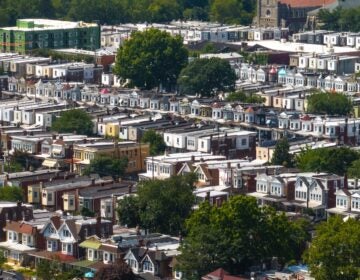A year of transition: Philly sees drop in poverty, violent crime, but deep-seated issues remain, Pew report says
The 2024 State of The City report outlined Philadelphia’s improving economic metrics — and ever-present factors that threaten future progress.
From Philly and the Pa. suburbs to South Jersey and Delaware, what would you like WHYY News to cover? Let us know!
Philadelphia is seeing tangible improvements in its poverty and violent crime statistics, but the opioid epidemic remains a massive hurdle for residents.
In this “year of transition” — a new mayor, fresh faces on Philadelphia City Council and new leadership taking the helm at major city institutions — the Pew Charitable Trusts finds persistent problems remain a threat to undermine progress.
Pew outlined the progress and problems facing Philadelphia in its annual “State of the City” report, which the nonprofit released Thursday morning.
“At least by historical standards, Philadelphia’s economy entered the year in relatively good condition,” Pew said in the report’s overview. “In 2023, the city’s unemployment rate was 4.2% on average, the lowest in more than 30 years, while the number of jobs in the city—an average of 765,400—was the highest in 40 years.”
For the first time in 16 years of Pew releasing the annual metrics, Philadelphia’s median household income of $56,517 surpassed Baltimore’s. The figure still pales in comparison to the national average of $74,755.
Despite these advances, economic growth was far from equitable. White, non-Hispanic households out-earned Black and Hispanic households on average by $40,000 a year.
Here are some highlights of the report:
Poverty declines, but drug overdoses remain high
The “State of the City Report” examines Philadelphia in a vacuum — but also compares it to nine comparable cities: Baltimore, Boston, Chicago, Cleveland, Detroit, Houston, Pittsburgh and Washington D.C.
Philadelphia has long held the unofficial moniker as America’s poorest big city. According to the latest data from 2022, Philadelphia’s poverty rate was 21.7%. Pew said that’s the lowest it’s been since the 1990s.
Meanwhile, Philadelphia’s deep poverty rate dropped to the single digits. Pew’s analysis of U.S. Census Data found that the percentage of people living in poverty varied dramatically between demographic groups. For example, children under the age of 18 experienced poverty at an almost 29% clip.
While Philadelphia has made advancements in addressing its poverty rate, the ongoing opioid epidemic remains at crisis level.
“The city recorded an estimated 1,300 unintentional drug overdose deaths in 2023, the seventh straight year with more than 1,100 such deaths reported,” Pew wrote in the overview. “Among the nine cities that The Pew Charitable Trusts has long used for comparison in its ‘State of the City’ reports, Philadelphia had the highest rate of drug overdose deaths: 78.9 for every 100,000 residents.”
If those numbers hold true for 2023, it would make it the second-highest overdose death total for Philadelphia on record.
Official numbers from the Philadelphia Department of Public Health are expected to be released in May.
Violent crime reaches 20-year low; homicide and property crime persist
Public safety has remained a top budget issue in Philadelphia. However, the city has managed to make inroads in its violent crime statistics, which are the lowest in a decade, according to Pew.
Meanwhile, Philadelphia’s homicide rate dropped six percentage points in 2023, in line with a trend shared with comparable cities.
In 2022, the Philadelphia Police Department reported 514 homicides. Last year, the number dropped to 410. The figure, although a 20% decline from the previous year, remains higher than pre-pandemic years.
Unlike the city’s violent crime and homicide, the number of property crimes, like car and retail thefts, skyrocketed in 2023. The total number of major crimes — which is the combined tally of violent crime and property crime — reached a 20-year high, Pew reported.
Philadelphians are more educated than ever
A major takeaway from last year’s iteration of the report was Philadelphia being the most college-educated it has ever been. That trend has continued — as has the city’s shrinking population.
Additionally, the number of uninsured city residents continues to plummet.
While Pew projects a municipal government with “relatively strong” fiscal health, the nonprofit defined the fiscal prospects of SEPTA and the School District of Philadelphia as “not so rosy.”
The expiration of federal relief aid has compounded other structural issues facing those institutions, Pew said.
“In this year of transition, the challenge is clear for Philadelphia and its new leaders: They must nurture and strengthen the positive trends while making progress on a set of deep-seated problems that can sometimes seem intractable,” Pew wrote. “That mission won’t be easy. But its success is essential for the future of the city and its people.”

Get daily updates from WHYY News!
WHYY is your source for fact-based, in-depth journalism and information. As a nonprofit organization, we rely on financial support from readers like you. Please give today.





